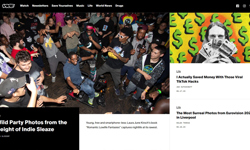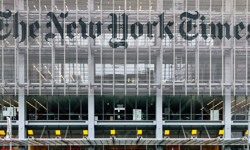Turbulent trading conditions and advertising volatility have taken their toll at The Guardian where, in July, Guardian Media Group confirmed losses of £69m for the twelve months to April 2016. Yet, under fresh leadership - David Pemsel and Katharine Viner: GMG chief executive and editor-in-chief, respectively - a bold new plan has been conceived and the publisher is now fighting back to achieve a goal of break-even within the next three years.
Looking back, 2015 was a turning point, says Pemsel, who moved to his current role within weeks of Viner taking up hers, in July 2015. A former ad agency boss, he joined Guardian News & Media (GNM), the publisher of the Guardian and Observer newspapers, in 2011 as chief marketing officer from ITV where he was marketing director. In 2012, he was appointed GNM’s chief commercial officer and then deputy chief executive.
“We had a unique moment when the editor-in-chief and chief executive were new so a chance to genuinely evaluate everything,” he explains. “It was a perfect opportunity to have a candid assessment of how was our performance and what we could see ahead.”
But there was another reason why mid-2015 was a watershed.
In previous years, the business had been paddling, hard, to grow digital revenues and maximise reach. And it achieved both. Back in March 2015, a GNM trading update stated the expectation that losses would remain flat as investment in editorial and commercial operations offset growing digital revenues. With digital sales over the year up 20%, GNM expected this would more than compensate for declines in print advertising and circulation.
What happened next was very different, however.
Advertising slump
The perfect storm that hit UK national newspapers in the summer of 2015 saw print advertising slump by unprecedented levels – as much as 30% in some weeks. Most of the UK’s top ten newspaper advertisers stripped their budgets and, worse, the digital ad revenue on which publishers were depending began to slow. Though overall, digital ad spend was up 30% year-on-year, the lion’s share of that went straight to Google and Facebook.
And a year on, market conditions are just as challenging.
Pemsel outlines on-going threats: programmatic increasing by 75% year-on-year; yield decline; audience shifting from print to mobile; and Google and Facebook, which according to one Morgan Stanley estimate took 85 cents of every new dollar spent on online advertising in Q1 2016.
This, then, is the new normal. Which is why The Guardian’s strategy had to change. It had transitioned successfully from a print organisation to a digital organisation with 155m unique monthly browsers. But its focus on growing audiences as quickly as possible to extend reach to secure advertising was no longer fit for purpose.
New strategy
Working closely, Pemsel and Viner formulated a new strategy comprising four pillars. The first was to cut costs by 20% - which it did with the reduction of 270 jobs within six months, though further cuts may still be to come. The second was a shift in emphasis away from maximising reach to building relationships with readers which led to the launch of the Guardian’s membership scheme.
The third was developing a more scaleable way of bringing to life its proposition to advertisers by, re-positioning the Guardian’s programmatic, native advertising, data analysis and content offerings as a single, united ‘Platform for Change’ proposition. This was launched by chief revenue officer Hamish Nicklin, former AOL managing director, in October. Finally, it is continuing to develop its activities in America and Australia so long as it can do so cost effectively - for the time being, at least.
The trouble with relying on maximising reach in today’s marketplace is that that reach is anonymous, says Pemsel.
“A figure on its own is not a foundation to monetise or base any future business model,” he explains. “That’s why the biggest pillar of our plan is … to direct and point the whole organisation – editorial, product and commercial – to understanding the relationship we have with our reader. From now, success will be defined by the strength of those relationships.” And what the business does with them, of course.
The launch of the membership strategy was interpreted by some observers as foreshadowing an eventual Guardian paywall. Not necessarily, Pemsel insists.
“If you are an organisation with a paywall the whole organisation is focused on conversion,” he points out. “But we don't want to do that.” Instead, the business is actively assessing what ‘membership’ can mean and working to understand the different kinds of relationship different readers want.
Membership model
As it currently stands, Guardian membership comprises different levels. Readers can receive regular updates from the membership community, book tickets and access the Guardian members’ area online by signing up for free. Or they can make a one-off financial contribution.
Alternatively, they can become a ‘supporter’ - paying £5 a month in exchange for little more than a branded tote bag and warm feeling, or a ‘partner’ - receiving tickets to live events or books, priority booking, a welcome pack and gift for £15 a month. A ‘patron’, meanwhile, can access exclusive, behind-the-scenes functions for £60 a month.
All members get access to live stream content and free access to the Guardian app’s premium tier. A members’ page provides event reviews by members, and a weekly newsletter directs members to content highlights. Members’ editorial queries, meanwhile, now receive a personal response – from a journalist.
Calls to action to prompt membership sign-up are also being tested in stand-firsts and footers, on core stories such as Brexit and Sports Direct, and in live blogs and email newsletters to see which work best to persuade readers to join.
“We want to understand the various relationships we can cultivate with our readers. And we have tested various models around what contributing to The Guardian looks like,” Pemsel says, referencing how Wikipedia (whose founder Jimmy Wales is on the GMG board) constantly tests: is Wikipedia a charity, or is it a community, or is it something people value and want to contribute to because it’s a great place to be.
“Contribution is nuanced and because of our three year plan, we can explore the extremities of what it looks like,” he continues. “We are confident we can build multiple relationships with our readers. One is membership. One is contribution. Some will want something back. Then there is another bucket - you pay us in return for certain content – which falls into the paywall approach.” Though, Pemsel quickly adds, paywall is “a blunt term”.
At present, The Guardian – which sells 157,317 copies Monday to Saturday – has 250,000 people paying for its journalism in some form, with 181,000 of these paying subscribers; 70,000 paying members; and a further 150,000 non-paying members who are ‘friends’. Though still in its early days, The Guardian is expected to have 100,000 paying members by December 2016 and the membership scheme is on track for generating one third of Guardian revenue within three years.
“Over the next few years, if we don’t think the contribution or community elements will be enough, we will explore various levels of pay in pursuit of break-even, but at the moment, we have the time to understand how far we can go (before doing so),” he says.
Culture change
Streamlining priorities and focus has been another important shift. It’s why the business pulled out of a plan to move into an events space across the road from its headquarters. And it’s why Pemsel and Viner also launched an internal strategy to change Guardian culture - away from an organisation driven by a belief survival lay in getting bigger, to one more agile and responsive to changing market needs.
The Guardian has always been innovative, he stresses. But the pace of innovation required in today’s marketplace needs to be fully embraced by everyone. And to this end, he and Viner have introduced a product development process favoured by tech companies based around objectives and key results - OKR. This has involved assembling cross-business groups of people quarterly to work in ‘huddles’ with each addressing key business issues, such as how to increase sign-in, or new ways to improve video discoverability.
“It is very, very new for The Guardian because it forces collaboration. And the first quarter was … interesting,” Pemsel admits. “But what I’ve seen in quarter three, every single person aligned behind the huddles we’ve established.” He adds: “We now feel like we work for a digital organisation that is innovating at pace under extreme pressure with lots of volatility, but Kath and I are in control, there is a strategy, and that can only be a good thing.”
At a time when news is becoming increasingly commoditised, Pemsel has no doubt The Guardian is well-positioned moving forward thanks to the unrivalled trust of its readers, the quality of its journalists and journalism and, of course, its new strategic plan.
“The one billion monthly page impressions we served across our platforms during the Brexit campaign alone tells you that, increasingly, people are turning to news organisations to make sense of the world … and that’s an opportunity to make sure we spread our message, and an opportunity commercially,” he says.
“From Syria to the Panama Papers to the stuff we did around Sports Direct – our content is critical now, more so than ever as people need organisations like this one to hold people to account.”
Just what that future will look like however, is less clear. Certainly, old business models and dependency on advertising will reduce. And Pemsel is confident that “genuine news organisations with integrity and trust” will successfully cultivate communities of readers and be funded by a number of different, diversified revenue streams.
“But does that mean you are bigger? Does that mean you are smaller? Does that mean you are local? Does that mean you are global? Today, really, you have no idea,” he admits. One thing is sure, though: “Being true to your editorial strategy and ensuring your editorial independence is protected (must be) absolutely bought into by everyone. Because without these things, you are nothing.”












